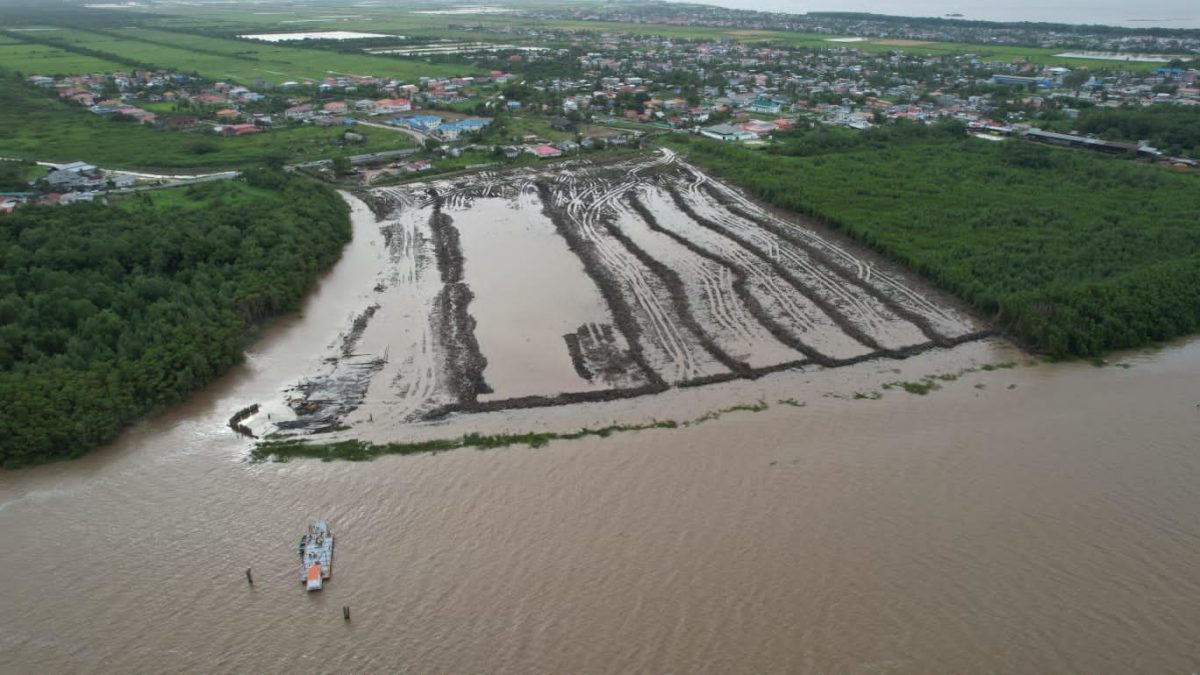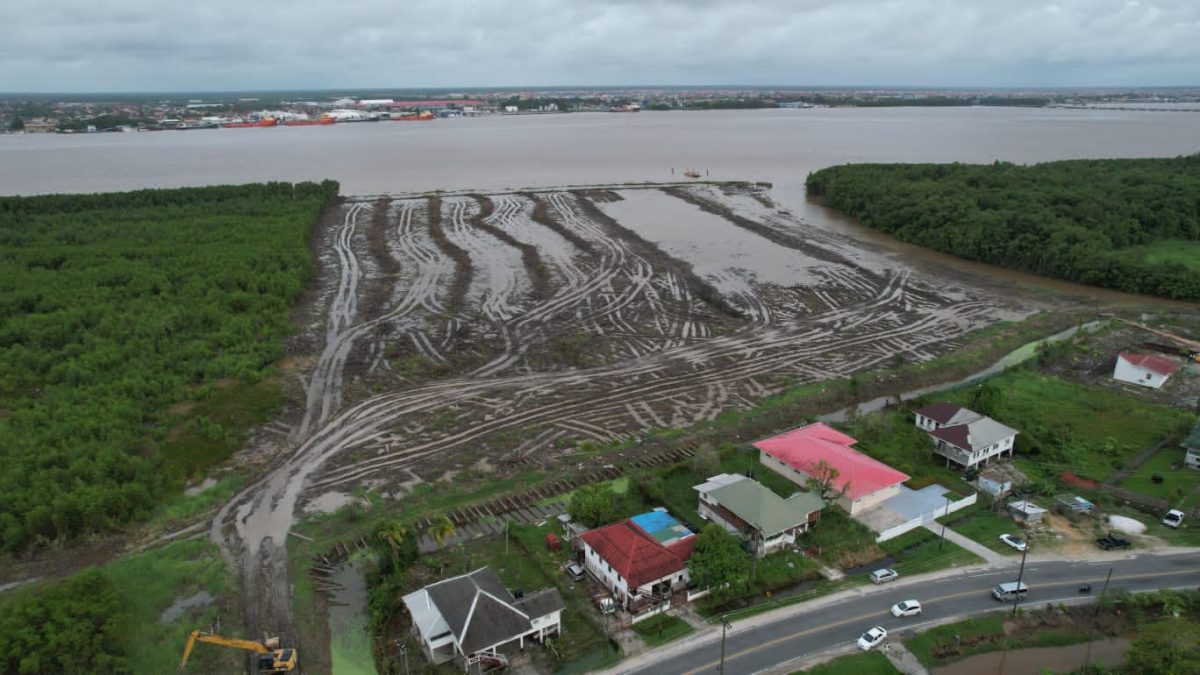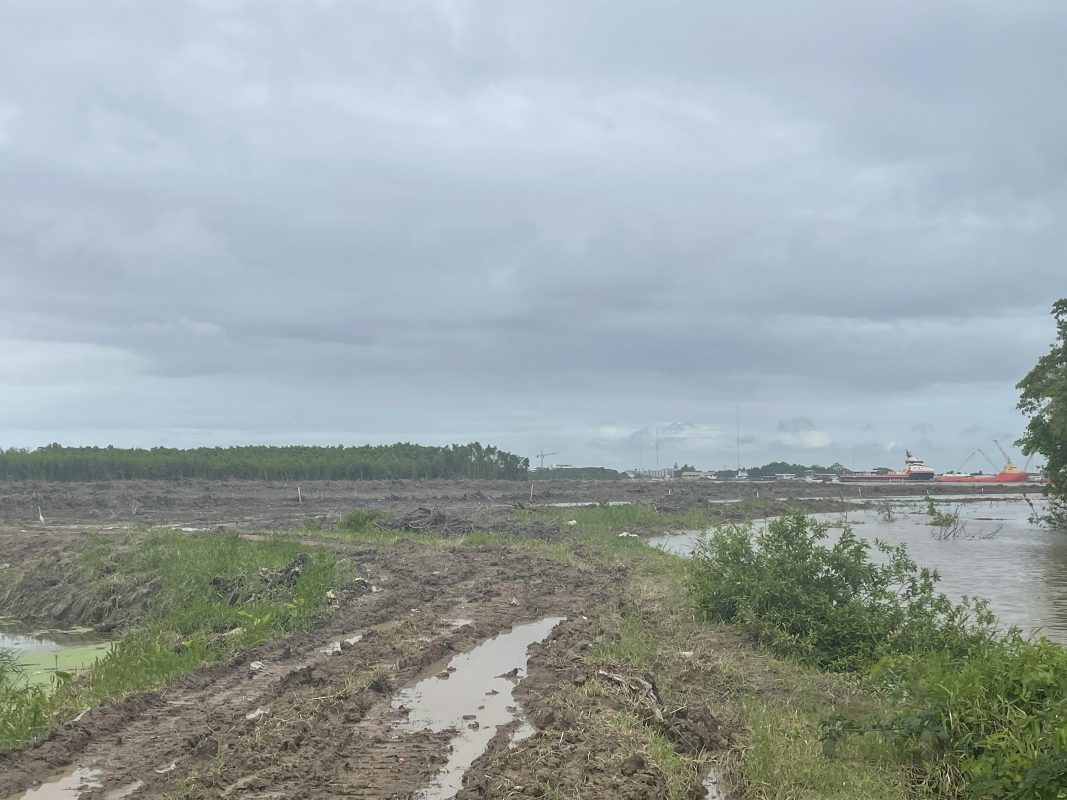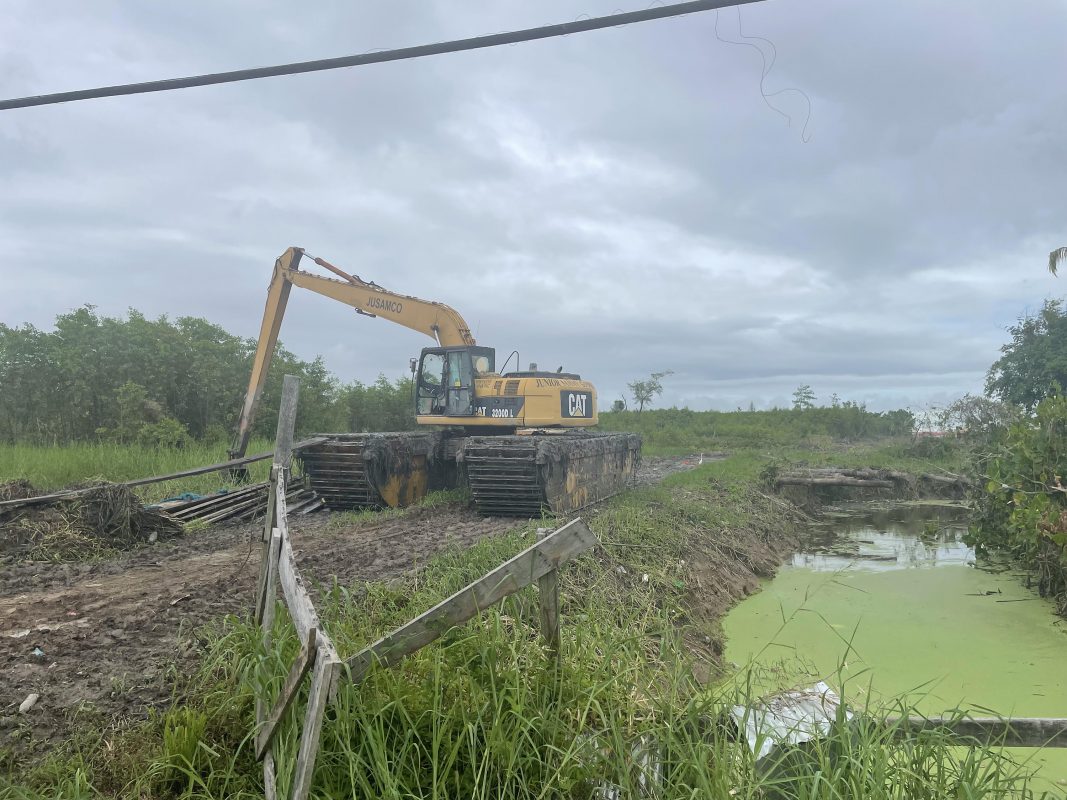Acres of mangroves protected by the Laws of Guyana have been ripped out from the west bank of the Demerara River to pave the way for the development of a second oil and gas shore base in the region.
TriStar investment, owned by Florida-based Guyanese, Krishna ‘Kris’ Persaud, is engaged in the land clearing exercise.
The Sunday Stabroek understands that the developer recently began land clearing in preparation for the construction of the shore base facility. Work had been stalled for over two years after the project and its developers faced heavy criticism for the removal of mangroves.
President Irfaan Ali while speaking at the opening of the Sheriff Medical Hospital in Leonora, West Coast Demerara on April 29 this year, hinted at commencement of works at the facility.
“In another two to three weeks, we will be launching a second shore base facility [in the region], an investment of over a $100 million US, by a Guyanese from the diaspora,” he said as he spoke of the type of investment occurring in the region.
During a recent visit to the location, the Sunday Stabroek observed that vast sections earmarked for the facility have been cleared of mangroves and other vegetation. The section from which mangroves were first ripped out remained intact. However, an excavator was close by which suggested by its presence that work will soon commence in that section.
From aerial images commissioned by this newspaper, it can be seen that the portion of the land, south of the Versailles sluice on the West Bank Demerara has now been flooded with water from the Demerara River. When the Sunday Stabroek approached the company for a comment, the engineer informed via another worker that he would not be able to speak in the absence of his boss.
Corlette (only name given), a pensioner who lives in the area, said it is unclear to him what has been happening. He explained that his fence fell during the land clearing operation so he reached out to the Neighbourhood Democratic Council to enquire what was happening but so far has received no response.
Corlette resides in one of the few houses occupied in the vicinity of the proposed shorebase. “Nobody has never told us what is happening. We just see them coming and doing work. They had started and then they stop. Now they come back again,” the pensioner pointed out while emphasising that the rear perimeter fence of his yard had collapsed. In the same breath, he noted that he could not understand how they will locate a wharf and shorebase facility directly behind their homes.
As a result of the pause in work in the last two years, mangroves had sprung up and reclaimed their place on the river bank. When Stabroek News visited the area in January 2021, mangroves were seen slowly returning to a state of normalcy as lush vegetation continued to grow and occupy the areas that were cleared. It was observed that the yards where materials were stored had also been taken over by vegetation and the materials had remained in the same position they were originally placed, a sign that infrastructural activity had been dormant for months.
As of last week, however, that land showed signs of some activity but materials for the sea defence remained where they were placed from the inception.
Protected species
Mangroves are a protected species in Guyana and it is illegal to remove them, but the government has sought to defend this as being ‘necessary’ for development. Mangroves sequester large amounts of carbon.
TriStar faced severe criticism in 2021 over its destruction of the large swathe of mangroves from its 66-acre property at Versailles/Malgre Tout as part of preparatory works for its planned shore base. Promises by the developer to construct a sea defence out of steel sheets in the area where the mangroves were removed are still to be fulfilled. Nearly 20,000 tonnes of steel sheet piles were being stockpiled by TriStar at its planned Malgre Tout offshore base as the company prepared to begin revetment works at the facility, Stabroek News reported in June 2021.
Previously, residents of Malgre Tout/Versailles had told this newspaper that there has been little to no flooding during spring tides. One man said that water normally accumulates in his backyard but it is unclear to him if the removal of the mangroves contributed to that or it was a case of poor drainage in the area.
Responding to questions posed by Stabroek News, Minister of Public Works, Juan Edghill, had said last year that government was aware of the importance of mangroves in the protection of Guyana’s sea and river defences. It is with this in mind, he said, that government will be planting more mangroves across the country.
“We value mangroves and we will plant more mangroves and where development is taking place where mangroves will be destroyed we will have to have some compensatory measure to ensure that everything is done sustainably…” he emphasised.
Government faced scathing criticism over the granting of permission for the removal of mangroves at the location for the development of the oil and gas shore base.
Following concerns by residents that they had been put at risk of flooding due to the clearance of the natural sea defence, Stabroek News reported that during preparation for the project, over 40 acres of mangroves were destroyed.
In 2021, Chairman of Guyana’s Sea Defence Board, Gary Beaton had told this newspaper that the company had cleared a large amount of mangroves, which it was not permitted to do, and had so far failed to make provisions to rebuild a river defence.
“They are in breach of the guidelines we offered with our no-objection. They have destroyed the sea defence without building one area, and they were expected to provide a work plan and schedule but that was not done,” Beaton responded when asked about the breaches committed by the developer. Since then, Beaton has not said anything else about the removal of the mangroves and the impact on sea defences.
“…The development that is taking place in Guyana is not willy-nilly. This is well-planned. Structured. Structured in a context to bring about real world-class development of Guyana… and that is not something to be sabotaged. That is something to be encouraged,” Edghill had stated during a press conference held in the boardroom of his Wight’s Lane, Kingston, Georgetown, office to address the removal of mangroves by TriStar Incorporated.
With Guyana now an oil producing country, Edghill contended that there are infrastructural developments that are required to facilitate and properly service what is taking place in the country’s Exclusive Economic Zone. In particular, he said that the development on the West Demerara to facilitate the “new wave of development coming to Guyana” would require the removal of mangroves. “At some stage, mangroves will be displaced,” he averred. “Mangroves will have to be removed.”
“…The big issue is not flooding because the adequacy of the measures, the hard structures to prevent flooding, are in place. So the big issue is if we should cut mangroves or don’t cut mangroves,” Edghill said back in May 2021.
Major agencies which are a part of the Sea and River Defence Board had offered their no-objection to the application to remove the mangroves in 2021. The Sea and River Defence Board comprises the Central Housing & Planning Authority (CH&PA), the Maritime Administration Department (MARAD), the National Agricultural Research and Extension Institute (NAREI), the National Drainage and Irrigation Authority (NDIA), and the Environmental Protection Agency (EPA).
TriStar in 2021, had said the company has assembled “a blue chip team” of highly qualified individuals and companies with vast experience in building and managing ports for the oil and gas industry.
To ward off criticism, the company had in 2021 donated money to the Guyana Marine Conservation Society (GMCS) to support scientific research in the Barima/Mora Passage mangrove forests, which it said is the largest and most intact mangrove ecosystem in Guyana. The GMCS said the donation would enable the start of a needed riverain fisheries study. “GMCS wishes to commend Tri Star for its tangible support in empowering local conservationists to carry out much needed scientific research which will contribute to the protection of this valuable ecosystem and the environment in Region 1,” it added.
Weeks after being criticised for uprooting the mangroves, the company had told this newspaper that nearly 20,000 tonnes of steel sheet piles were available to construct a revetment of the lands.
“When completed, the project will be a dedicated oil and gas shorebase with six berths. It will be operated to international standards, including ISO 45001, ISO 9001 and ISO 14001, as well as ISPS port security standards. The shore base will be operated to the highest international Health, Safety, Security and Environmental (HSSE) standards. As a dedicated oil and gas facility, the WDSB will allow for optimal control of logistics and management of HSSE,” the company representative had told Stabroek News.
Construction of the facility was set to start in the last quarter of 2021 and it was anticipated that the project would be completed by the third quarter of 2023. Then Project Manager, Narendra Sukhdeo, had told Stabroek News in an interview that the revetment works were catered for and that the sheet piling was evidence of that commitment. He had also explained that the project capitalisation was pegged at between US$100-150 million and when completed would see the employment of about 250 to 300 persons in the first phase.
“The Versailles shore base will stimulate the overall economic development of West Bank, Demerara. TriStar’s vision is to develop a ‘win-win’ shore base project that aligns with the goals of the Government of Guyana and to also produce substantial socioeconomic benefits to the West Bank Demerara region,” Sukhdeo said, explaining the project’s intent.











